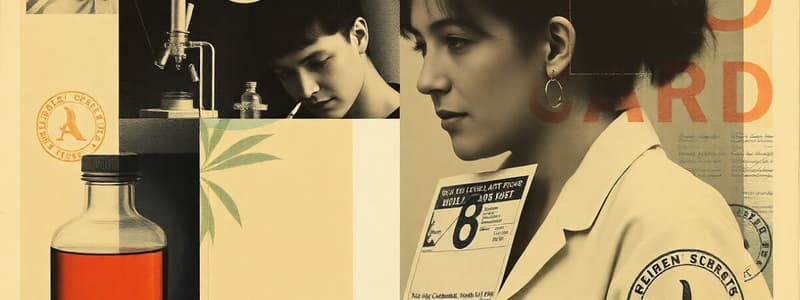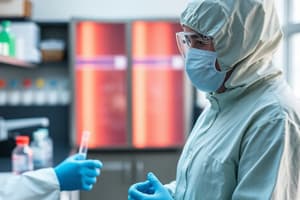Podcast
Questions and Answers
What is the main focus of GLP regulations?
What is the main focus of GLP regulations?
- Controlling the packaging process of products
- Ensuring product quality during manufacturing
- Verifying the final product before market release
- Maintaining data integrity during product development (correct)
Which of the following is NOT part of the GMP regulations according to the EU?
Which of the following is NOT part of the GMP regulations according to the EU?
- Market Approval (correct)
- Self-inspection
- Quality Management
- Contract manufacturing & analysis
Which of the following aspects is included in the Five Ps of GMP?
Which of the following aspects is included in the Five Ps of GMP?
- Premises can be informal as long as products are high quality
- Products must follow standard operating procedures (correct)
- Processes must be innovative and change frequently
- Personnel must be untrained to allow fresh perspectives
What aspect of GMP addresses the need for appropriate testing before product release?
What aspect of GMP addresses the need for appropriate testing before product release?
Which regulation applies specifically to Investigational medicinal products?
Which regulation applies specifically to Investigational medicinal products?
What is one of the requirements for premises under GMP regulations?
What is one of the requirements for premises under GMP regulations?
Which directive focuses on medicines for human use?
Which directive focuses on medicines for human use?
What distinguishes GLPs from GMPs?
What distinguishes GLPs from GMPs?
What is the primary focus of Good Laboratory Practice (GLP)?
What is the primary focus of Good Laboratory Practice (GLP)?
What is the main purpose of Good Manufacturing Practice (GMP)?
What is the main purpose of Good Manufacturing Practice (GMP)?
Which organization regulates GLP in the European Economic Community (EEC)?
Which organization regulates GLP in the European Economic Community (EEC)?
What do internal quality control (IQC) procedures primarily help to identify?
What do internal quality control (IQC) procedures primarily help to identify?
In which year did the US FDA release GLP regulations?
In which year did the US FDA release GLP regulations?
What does the 'c' in cGMP stand for?
What does the 'c' in cGMP stand for?
Which of the following is NOT an area of application for GLP?
Which of the following is NOT an area of application for GLP?
What type of products do GMP regulations apply to in the US?
What type of products do GMP regulations apply to in the US?
What is one common fault in laboratory equipment related to pipettes?
What is one common fault in laboratory equipment related to pipettes?
What is essential for ensuring that methods used in a laboratory are reliable?
What is essential for ensuring that methods used in a laboratory are reliable?
Which of the following is NOT a reason for data errors in laboratory reports?
Which of the following is NOT a reason for data errors in laboratory reports?
Why is staff training crucial in a laboratory setting?
Why is staff training crucial in a laboratory setting?
What does the validation of an analytical method primarily ensure?
What does the validation of an analytical method primarily ensure?
Which factor can affect the reliability of data from bioanalytical methods?
Which factor can affect the reliability of data from bioanalytical methods?
What is a potential error related to centrifuges in the lab?
What is a potential error related to centrifuges in the lab?
Which of the following is a requirement for reagents and standards in a laboratory?
Which of the following is a requirement for reagents and standards in a laboratory?
Flashcards
GMP (Good Manufacturing Practices)
GMP (Good Manufacturing Practices)
A set of regulations that ensure the safety and quality of pharmaceutical products. They outline guidelines for the manufacturing process, from the initial formulation to the final product.
EU Regulations for human medicines
EU Regulations for human medicines
The regulations that specifically apply to manufacturing medicines for human use.
EU Regulations for veterinary medicines
EU Regulations for veterinary medicines
The regulations that specifically apply to manufacturing medicines for animals.
EU Regulations for Investigational medicinal products
EU Regulations for Investigational medicinal products
Signup and view all the flashcards
GLP (Good Laboratory Practices)
GLP (Good Laboratory Practices)
Signup and view all the flashcards
Difference between GLP and GMP
Difference between GLP and GMP
Signup and view all the flashcards
GLP for pre-clinical trials
GLP for pre-clinical trials
Signup and view all the flashcards
GMP for product manufacturing
GMP for product manufacturing
Signup and view all the flashcards
Equipment Faults
Equipment Faults
Signup and view all the flashcards
Standardized Procedures
Standardized Procedures
Signup and view all the flashcards
Reagents and Standards
Reagents and Standards
Signup and view all the flashcards
Staff Training
Staff Training
Signup and view all the flashcards
Data Errors
Data Errors
Signup and view all the flashcards
Method Validation
Method Validation
Signup and view all the flashcards
Sample Handling
Sample Handling
Signup and view all the flashcards
LLOQ and ULOQ
LLOQ and ULOQ
Signup and view all the flashcards
Good Laboratory Practice (GLP)
Good Laboratory Practice (GLP)
Signup and view all the flashcards
Good Manufacturing Practice (GMP)
Good Manufacturing Practice (GMP)
Signup and view all the flashcards
Error Detection in GLP
Error Detection in GLP
Signup and view all the flashcards
Systematic Error
Systematic Error
Signup and view all the flashcards
Random Error
Random Error
Signup and view all the flashcards
GLP and Regulatory Submissions
GLP and Regulatory Submissions
Signup and view all the flashcards
GMP and Consumer Safety
GMP and Consumer Safety
Signup and view all the flashcards
Current GMP (cGMP)
Current GMP (cGMP)
Signup and view all the flashcards
Study Notes
Good Laboratory Practice (GLP) & Good Manufacturing Practice (GMP)
- Internal quality control (IQC) procedures are designed to detect and distinguish between systematic and random error.
- The source of error must be identified to eliminate it.
- Good Laboratory Practice (GLP) involves all aspects of the laboratory involved in generating an analytical result.
- Good Manufacturing Practice (GMP) ensures manufactured products meet quality standards by setting specifications and requirements for the production and testing process.
Learning Objectives
- Define GLP
- Define GMP
- Describe sources of error in GLP
GLP - Sources of Error: Equipment
- Written instructions (SOPs) should be located with the equipment.
- Laboratories should have a program of regular inspections, calibration, and preventative maintenance.
- Good records help locate sources of error.
- Common equipment faults include contaminated or incorrectly calibrated pipettes and dispensers, dirty or imbalanced centrifuges, spectrophotometer inaccuracies (stray light, temperature changes), mismatched or dirty cuvettes, and improperly calibrated pH meters with temperature effects.
GLP - Sources of Error: Procedures
- All methods must be standardized, fully documented, and appropriate for analysis.
- Standard Operating Procedures (SOPs) should be available and contain details on sample handling, analytical procedures, and quality control (QC) measures and equipment use.
- Reagents and standards must be carefully checked for impurities, instability, improper preparation, inadequate labeling, incorrect storage, and contamination.
GLP - Sources of Error: Staff
- Staff must be trained with correct responsibilities, techniques, standard operating procedures (SOPs), and equipment use, as well as record-keeping.
GLP - Sources of Error: Data
- Calculations must be accurate, including correct dilution factors, calculation errors, and correct units.
- Reports must be accurate, including transcribing errors of data, and avoiding misunderstandings of units and ensuring reports are legible and easy to interpret.
FDA Guidelines on Analytical Method Validation & Control
- Validating an analytical method ensures data reliability by addressing key questions:
- Does the method measure the intended analyte? (e.g., interference, specificity)
- What is the variability associated with measurements? (e.g., accuracy, precision)
- What is the range in measurements that provide reliable data? (e.g., sensitivity, lower and upper limits of quantitation (LLOQ and ULOQ))
- Sample collection, handling, and storage affect data reliability.
- Method development includes optimization, validation, and control of parameters like:
- Reference standards
- Critical reagents
- Calibration curve
- Quality control samples (QCs)
- Selectivity and specificity
- Sensitivity
- Accuracy
- Precision
- Stability of the analyte, and matrix.
GMP Regulations in the EU & EMA
- Regulation No. 1252/2014 applies to active substances for human use.
- Directive 2001/83/EC and Directive (EU) 2017/1572 apply to medicines for human use.
- Directive 91/412/EEC and Regulation (EU) 2019/6 apply to medicines for veterinary use.
- Directive 2001/20/EC and Regulation (EU) 536/2014 apply to Investigational medicinal products.
Five Ps of GMP (US)
- People: Training in cGMPs and responsibilities for maintaining quality.
- Products: Produced according to standard operating procedures (SOPs) and appropriately tested before release.
- Processes: Standardized and maintained throughout manufacturing.
- Procedures: Well-designed, documented, and understood by all employees.
- Premises: Designed to reduce risks of contamination and accidental mislabeling. Requirements include washing facilities, sewage, lighting, and plumbing, meeting documented specifications for accuracy, sensitivity, specificity, and reproducibility.
GMP Requirements in the EU
- Quality Management
- Personnel
- Premises & equipment
- Documentation
- Production
- Quality control
- Contract manufacturing & analysis
- Complaints & product recall
- Self-inspection
GLP v's GMP
- GLP focuses on pre-market product development and data integrity (testing), while GMP focuses on production.
- GLP roots are in pharmaceutical industry preclinical drug development and data generation related to obtaining drug approval.
- GLPs apply to food and colour additives, food packaging, food contamination limits, and medical devices.
- GMP regulations apply when products are being manufactured for sale.
- GMP involves lot or batch testing, testing of ingredients from suppliers, and any testing during manufacturing.
Studying That Suits You
Use AI to generate personalized quizzes and flashcards to suit your learning preferences.
Related Documents
Description
This quiz covers the essential principles of Good Laboratory Practice (GLP) and Good Manufacturing Practice (GMP). Focus on internal quality control, identifying sources of error, and the importance of maintaining equipment standards. Test your understanding of the definitions, objectives, and critical practices in laboratory settings.




